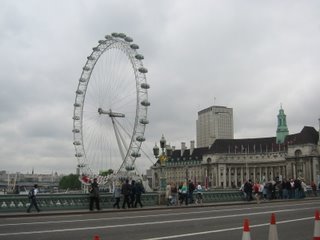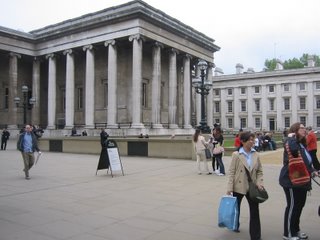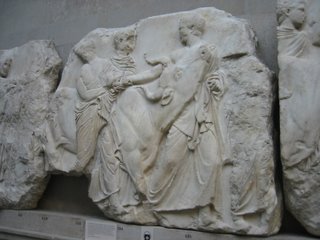London with the Kids
We took the kids to London for the day on Thursday. They certainly made the most of the time. Sara and Keith didn't arrive back in Cambridge until 1:00 am (due to train track maintenance). Here are some of our pictures for the day.

We took them to Buckingham Palace so they could (try to) see the Changing of the Guard.

This picture, of St. James Park right in front of the Palace, shows how the spring colors have come to London.

On our way from the Palace to Westminster we passed the glorious Abbey church.

We were at Big Ben when the clock struck noon. A discussion of the tune for the bell chimes enlivened our discussion for much of the rest of the afternoon.

This is the riverside of the Westminster Palaces, where the House of Lords and the House of Commons are located.

The London Eye sits directly in front of the London Aquarium.

This monument depicting Boudicca, Queen of the Iceni, stands at the foot of Westminster Bridge. Boudicca led a famous (and ultimately unsuccessful) revolt agains the Romans at roughly the same time that St. Paul was evangelizing in Rome.

This is Downing Street, where Tony Blair resides. Needless to say, the security fence at the top of the street was very high and well guarded.

Admiralty Arch is at the opposite end of St. James Park from Buckingham Palace and opens into Trafalgar Square.

Trafalgar Square contains the National Gallery (mostly paintings), St. Martin-in-the-Fields Church (to the right), and Nelson's Column (not pictured: unfortunately, the Column was scaffolded up, probably for cleaning). The Canadian Embassy is located off to the left of this picture.

This beautiful fountain lies directly in front of the National Gallery.

Here's another part of the fountain.

St. Martin-in-the-Fields Church is one of the most important in London.

Look at how beautiful and grand the inside of this eighteenth century church is!

This picture shows not only the arches, but the organ.

We walked on to Covent Garden, certainly the place to be for young adults at night. St. Paul's Church (not the famous Cathedral) sits at one end of Covent Garden. Performers act in the square out front.

Here's another view of Covent Garden. . .

. . . and yet another one. . .

. . . and finally, one more.
We then split up our party: the kids went to visit St. Paul's Cathedral and Tower Bridge, while Mom & Dad spent the afternoon at the British Museum.

One look at the outside of the museum and it was obvious we wouldn't have the time (or energy) to see the entire collection today.

The main entrance is off to the left of this picture; the building is classically symmetrical.

This photo shows part of the (recently enclosed) rotunda of the museum, also known as The Great Court.

Here's a view of Queen Elizabeth Hall, the Reading Room of the former British Library (which moved out to new digs at St. Pancras in the 1980s).

The circular Reading Room was spectacular. It was built between 1854-7 and is where Karl Marx wrote Das Kapital.

Here's another view of the Reading Room.

In the Museum galleries we concentrated on antiquities. This huge Assyrian human-headed winged lion dates from 865 BC.

Danny loved the displays of cuneiform writing.

This is arguably the most famous artifact in the museum: the Rosetta Stone. It really was incredible to see it up close. We were reminded of the full-size replica that sits in the foyer of the Phillips Library at our alma mater, Providence College, and greeted us whenever we went to the library to study.

The Nereid Monument pictured here dates from about 400 BC.

The Parthenon exibit was spectacular as well. It was housed in a room whose dimensions matched the Parthenon. The walls were lined with friezes like the one pictured here (from the North side of the building).

The room also contained Metopes. The detail we saw in these sculptures was amazing!

Climbing the stairs to the first floor, we passed beautiful mosaics like this one of Spring. It reminded us of the lovely mosaics in the Roman Museum in Cirencester.

The mummy exhibit was very popular, of course. This picture shows a pair of mummy cases.

Here is the mummy of Cleopatra (from the 2nd century AD). What was fascinating was that next to the exhibit was an x-ray image of the interior of the mummy.

This ivory piece depicts the Resurrection and dates to the 14th century.

Saints Cosmas and Damian are depictted in this 17th century icon.

Deb absolutely loved this 1589 Habrecht clock! It did everything!

We returned to Covent Garden to meet up with the kids. Along the way, we passed this icon of Britishness, a brolly shop! (That's an umbrella shop, for you Yanks.)

We walked directly beneath the London Eye (hoping to take a ride). It looks like it's going to fall into the Thames at any moment! But we decided against it at the end (£65, even for the unique view, didn't seem worth it).

This view of the Westminster Palace was taken from in front of the London Aquarium.

This sculpture of Dali's iconic melting clock was located on the river side of the London Aquarium outside the Dali's Universe gallery at the Council Hall.

This final picture is of Scotland Yard seen from across the Thames.
We had a very long, but wonderful day in London!

1 Comments:
I'm puzzled by your comments that the metopes were postitioned in the exact same places as they were on the Parthenon. In the British Museum, they are in four different corners of the gallery, whereas on the Parthenon they were originally all arranged along the same side of the building.
The New Acropolis Museum in Athen (currently under construction) does a far better job of relating the positions of the sculptures to the positions that they actually ocupied on the Building.
Post a Comment
<< Home